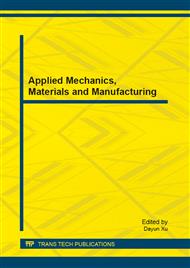[1]
A.O. Purdon: The action of alkalis on blast-furnace slag, Journal of the Society of Chemical Industry Vol. 59 (1940), pp.191-202.
Google Scholar
[2]
V.D. Glukhovsky: Gruntosilikaty (Grosstrojizdat, Ukraine, Kiev 1959).
Google Scholar
[3]
V.D. Glukhovsky: Soil Silicate Articles and Structures ( Budivelnyk Publisher, Ukraine, Kiev 1967), p.156.
Google Scholar
[4]
J. Davidovits: Geopolymers: inorganic polymeric new materials, Journal of Thermal Analysis 37 (8) (1991), p.1633–1656.
DOI: 10.1007/bf01912193
Google Scholar
[5]
A. Palomo, F.P. Glasser: Chemically bonded cementitious materials based on metakaolin, Br. Ceram. Trans. J. 91 (1992), p.107–112.
Google Scholar
[6]
L. Weng, K. Sagoe-Crentsil, T. Brown, S. Song: Effects of aluminates on the formation of geopolymers, Mater. Sci. Eng. B-Solid State Mater. Adv. Technol. 117 (2) (2005), p.163–168.
DOI: 10.1016/j.mseb.2004.11.008
Google Scholar
[7]
J.L. Provis, G.C. Lukey, J.S.J. van Deventer: Do geopolymers actually contain nanocrystalline zeolites? – A re-examination of existing results, Chemistry of Materials 17 (2005), pp.3075-3085.
DOI: 10.1021/cm050230i
Google Scholar
[8]
P. Duxson, S.W. Mallicoat, G.C. Lukey, W.M. Kriven, J.S.J. van Deventer: The effect of alkali and Si/Al ratio on the development of mechanical properties of metakaolin-based geopolymers, Colloids and Surfaces A – Physicochemical and Engineering Aspects 292 (2007).
DOI: 10.1016/j.colsurfa.2006.05.044
Google Scholar
[9]
A. Fernández-Jiménez, A. Palomo, M. Criado: Alkali activated fly ash binders. A comparative study between sodium and potassium activators, Materiales de Construcción 56 (2006), pp.51-65.
DOI: 10.3989/mc.2006.v56.i281.92
Google Scholar
[10]
A. Fernández-Jiménez, D.E. Macphee, E.E. Lachowski, A. Palomo: Immobilization of cesium in alkaline activated fly ash matrix, Journal of Nuclear Materials 346 (2005), pp.185-193.
DOI: 10.1016/j.jnucmat.2005.06.006
Google Scholar
[11]
C. Shi, P.V. Krivenko, D.M. Roy: Alkali-Activate Cements and Concretes (Taylor and Francis, Abingdon, The United Kingdom 2006).
Google Scholar
[12]
F. Pacheco-Torgal, J. Castro-Gomes, S. Jalali: Alkali-activated binders: A review: Part 2. About materials and binders manufacture, Construction and Building Materials 22 (2008), pp.1315-1322.
DOI: 10.1016/j.conbuildmat.2007.03.019
Google Scholar
[13]
A. Fernandéz-Jimenéz, A. Palomo, M.M. Alonso: Alkali activation of fly ashes: mechanisms of reaction, Proceeding Non traditional Cement and Concrete (CZ, Brno 2005), pp.13-14.
Google Scholar
[14]
S. S. Kouassi, M. T. Tognonvi, J. Soro, S. Rossignol: Consolidation mechanism of materials obtained from sodium silicate solution and silica-based aggregates, Journal of Non-Crystalline Solids 357 (2011), pp.3013-3021.
DOI: 10.1016/j.jnoncrysol.2011.04.006
Google Scholar
[15]
C. Shi, A. Fernandéz-Jimenéz, A. Palomo: New cements for the 21st century: The pursuit of an alternative to Portland cement, Cement and Concrete Research 41 (2011), pp.750-763.
DOI: 10.1016/j.cemconres.2011.03.016
Google Scholar
[16]
V.F.F. Barbosa, K.J.D. MacKenzie: Synthesis and thermal behaviour of potassium sialate geopolymers, Materials Letters 57 (2003), pp.1477-1482.
DOI: 10.1016/s0167-577x(02)01009-1
Google Scholar
[17]
P. Duxson, G.C. Lukey, J.S.J. van Deventer: Thermal evolution of metakaolin geopolymers: Part 1 – Physical evolution, Journal of Non-crystalline Solids 352 (2006), pp.2186-2200.
DOI: 10.1016/j.jnoncrysol.2006.09.019
Google Scholar
[18]
F.L. Roberts, P.S. Kandhal, E.R. Brown, D. Y Lee, T.W. Kennedy: Hot Mix Asphalt Materials, Mixture Design and Construction (National Asphalt Pavement Association Education Foundation, Lanham, 1996).
Google Scholar


